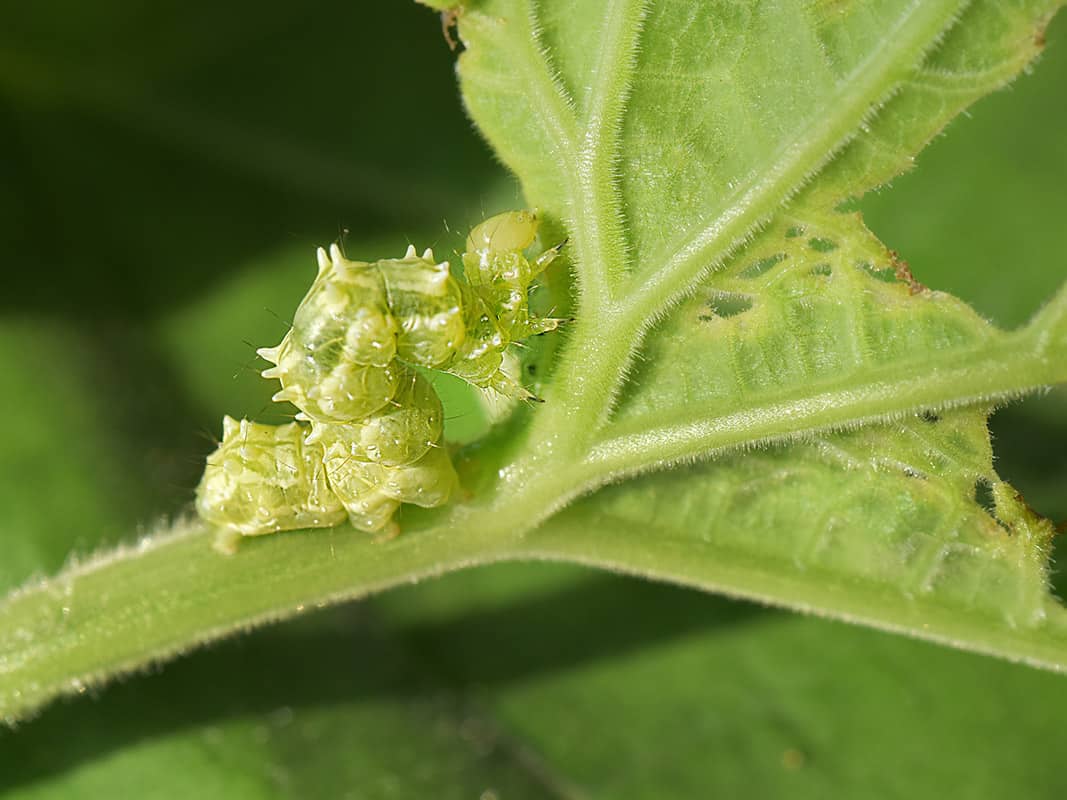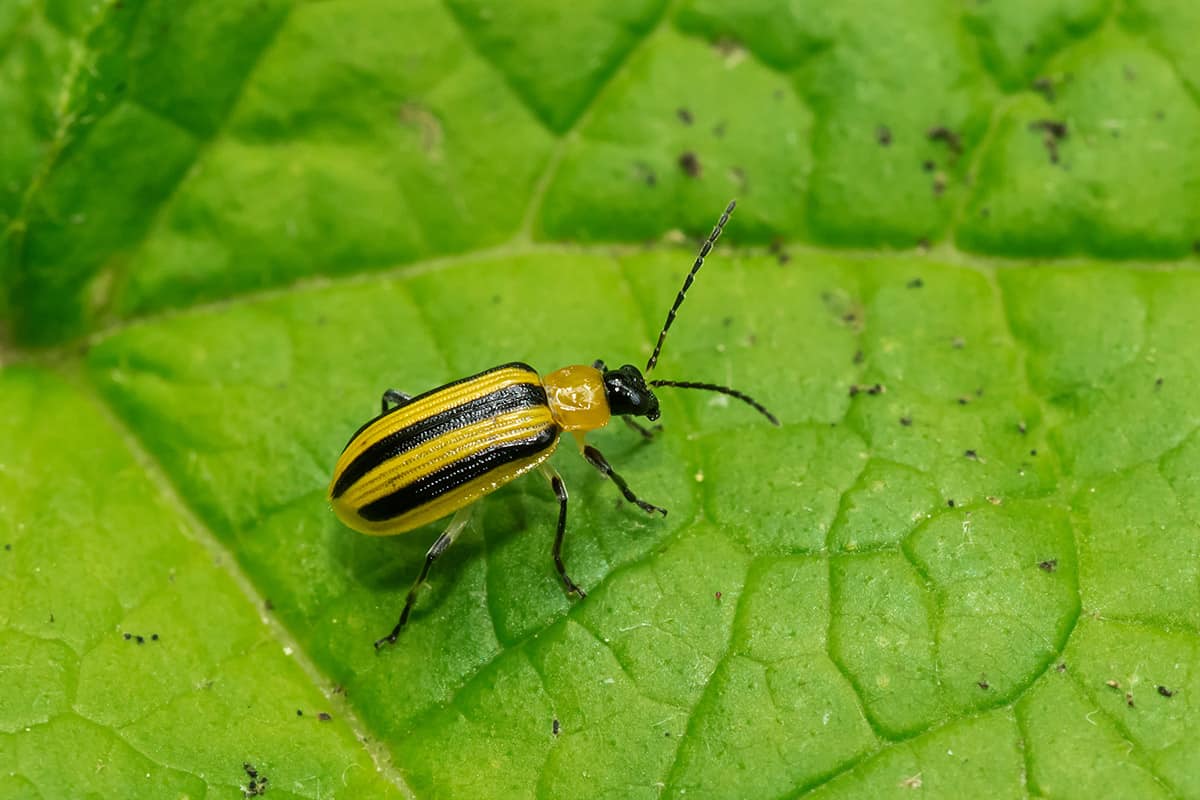
We may earn a commission if you purchase an item via one of the links on this page. Commissions have no effect on our editorial content. The entire disclosure is available to read.
Since they’re simple to grow, versatile, and tasty, cucumbers are one of the greatest summer veggie crops. Cucumber plants yield a lot of cucumbers, but pests can hit the harvest of even the most experienced gardener.
Cucumber pests are harmful to your plants in a variety of ways, including reducing production and killing them. As a result, it’s critical to understand the insects that you may encounter and how to cope with them.
Here are the most common to keep an eye out for.
The Most Common Cucumber Pests
Here are the most common cucumber pests that you might encounter in your garden.
1. Aphids

Aphids are tiny, delicate insects that prefer to reside underneath plant leaves and stems. Green or yellow aphids predominate, however pink, brown, red, and black aphids also exist.
In small quantities, aphids are usually harmless, but severe infestations may cause yellow or twisted leaves, necrotic lesions on the leaves, or stunted development.
Honeydew is a sticky, sugar-rich substance that aphids emit. This chemical attracts ants and causes a black growth on your plants, which is aided by sooty mold.
Here are some suggestions for dealing with aphids.
- ISpray the plants with a powerful stream of water to knock the aphids off of the leaves if they are robust and healthy.
- Prune away branches and leaves that are heavily infested with aphids.
- To discourage aphids from landing and feeding on your plants, place reflective mulches like silver-colored plastic around the base of your plants.
- Insecticides are required in severe cases to solve the problem. Insecticidal soap and Neem oil are two examples of organic options.
2. Cabbage Loopers

While searching for cucumber pests, don’t forget cabbage loopers (Trichoplusia ni). Little, light green caterpillars with white stripes down their sides are known as cabbage loopers.
Hole chewing through the leaves may cause significant harm. You might have a few tiny holes at one time, and huge damage that destroys leaves at another.
Cabbage loopers arch their bodies when they move (giving them the moniker inchworm) making it simple to identify them. Single eggs are placed on the leaves, not in clusters, if you look closely.
Getting Rid of Cabbage Loopers
Cabbage loopers are difficult to manage, however here are a few ways.
- Release beneficial insects and natural enemies, like parasitic wasps, to control the looper population.
- Handpick the eggs and worms from the plant or trim off infested sections.
- Bacillus thuringiensis, an organic control method that kills larvae, may be useful in situations like this.
3. Cucumber Beetles
One of the most difficult cucumber pests to manage is cucumber beetles. Depending on where you live, one of these two species will attack you:
Striped cucumber beetles (Acalymma vittatum)

Spotted cucumber beetles (Diabrotica undecimpunctata)

Both species eat holes in your plant’s leaves and flowers, and they feed on cucumber plants. Plant roots are the food of the larvae.
Several symptoms and problems caused by cucumber beetles are similar to those caused by bacterial wilt. Cucumber beetle symptoms may include:
- Stunted seedlings and growth.
- Damaged leaves, stems, or petioles.
- Reduced plant strength.
- Scars on the fruit.
Dealing with Cucumber Beetles
Cucumber beetles are a challenge to handle, but there are a few things you can do.
- Plant beetle-resistant varieties. Two options are ‘Saladin’ and ‘Gemini;’ both of which are excellent.
- Cover the plants with a floating row cover after the seeds germinate until they start to flower. Then, remove it, allowing pollinators to access your plants.
- Trap the beetles with yellow sticky traps. Watch out, though. This method also traps pollinators and beneficial insects.
4. Cutworms

Cutworms chop off the stems of young plants or seedlings at the soil line, destroying them. Cutworms create uneven holes on the surface of the fruits at times.
It’s difficult to detect Cutworm larvae because they are active at night and hide during the day. They burrow beneath the ground or among plant trash. When startled, they usually curl into a C-shape.
These insects target a variety of crops, including cucumbers but not exclusively. Asparagus, beans, cabbages, carrots, peas, and peppers are also infested with cutworms.
How to Get Rid of Cutworms
After harvesting cucumber plants or two weeks before planting, make sure to remove all plant debris. In addition to getting rid of cutworms, there are a few other things you can do.
- Make a three-inch-thick collar made of either plastic or foil that fits tightly around the plant stems and is placed three inches deep into the soil.
- At night, go to your garden and pick the larvae you find there.
- Around the root of your plant, spread diatomaceous earth. DE creates a cutting barrier to crawl through, which will hurt them.
- Insecticides may be used to treat infected regions in serious cases.
5. Flea Beetles

Flea beetles are tiny, dark insects that range in length from 1.5 to 3 mm. The carapace of these insects is usually glossy and iridescent. When startled, flea beetles jump like fleas, earning their name.
Flea beetles are more likely to attack young plants than older plants; as a result, older plants are more resistant to flea beetle infestations.
These insects create little holes or pits in the leaves, and the leaf damage may stunt vegetation growth. Plants may die from severe infestations.
Getting Rid of Flea Beetles
If you face a flea beetle infestation, here are some suggestions to help get rid of them.
- Floating row covers may be used to prevent flea beetle infestation before it happens.
- Plant trap crops nearby to protect yourself from flea beetles; cruciferous plants are the most common.
- Apply a layer of mulch beneath your plants to prevent them from reaching the top of the soil surface.
- Diatomaceous earth or Neem oil are two effective methods of controlling populations.
6. Slugs & Snails

Slug and snail problems are without a doubt a big issue for gardeners. They attack both vegetables and flowers, devouring them quickly.
Garden beds that don’t get enough air circulation or sunlight are preferred by these pests. The best strategy to keep slugs and snails out of your garden is to keep the region dry and devoid of leaf debris. Since they need damp surroundings, this is a must.
Dealing with Slugs and Snails
The best way to deal with slugs and snails is to prevent them from coming into your garden in the first place. Here are some suggestions.
- Water your cucumber plants only after the soil has dried completely.
- Remove any leaf litter that might retain moisture.
- Remove any insects that your cucumber plants may have and get rid of them.
For more information on preventing and removing slugs and snails, please read our guide.
7. Thrips

Thrips are a further problem with cucumber pests that you may encounter. Wilted, distorted leaves with coarse stippling and a silvery sheen are caused by a large population of thrips. Finally, thrip feces turn black.
It’s difficult to detect thrips with your naked eye because they are tiny, measuring 1.5 mm. Using a magnifying glass is the simplest way to look at them.
The thrips are yellow to brown in color, while the nymphs are even lighter and whiter.
Taking Care of Thrips
There are a several things that you can do to take care of a thrip infestation.
- Because thrips are attracted to onions and garlic, avoid planting cucumbers near them.
- To discourage thrips from invading your plants, use matt-surface mulches.
- Insecticides may be used to treat large infestations.
8. Whiteflies

Whiteflies infest cucumber plants in large numbers, and greenhouse and Silverleaf whiteflies are the most harmful. Both species are difficult to identify because they are so small. You need a hand lens to see them.
Whiteflies feed on the sap of the plant and prefer to feed on the underside of leaves. Infested plants reduce productivity and cause plant desiccation.
Handling Whiteflies
The only time you need to use insecticides is when you have significant silverleaf whitefly infestations. Here is what you can do.
- To keep whiteflies from discovering your plants, use floating row covers.
- To keep whiteflies away from your plants, apply reflective mulches around the roots.
- To avoid complications, clear out any crop debris and keep your garden beds clean.